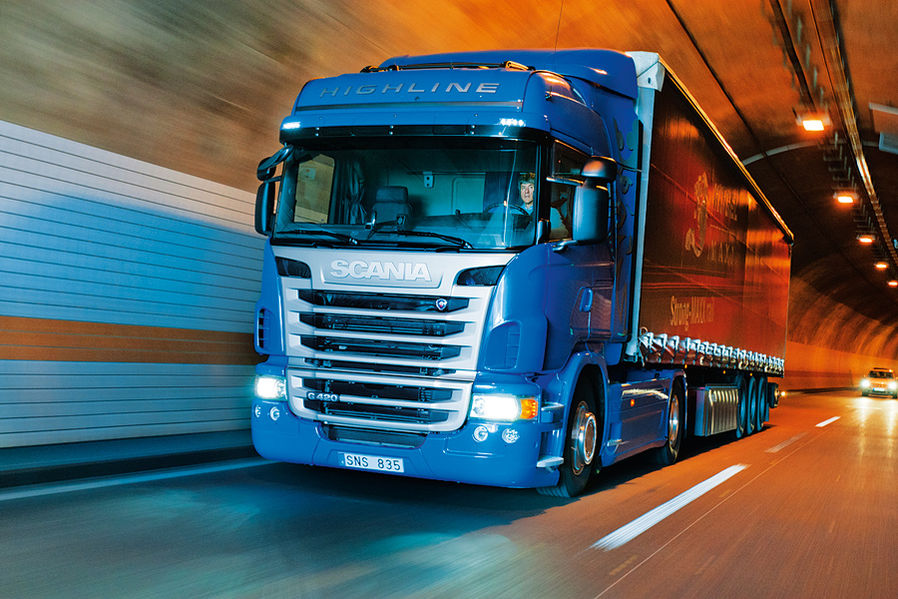
The Scania G 420 comes pretty close to being a jack of all trades. With its SCR engine, the truck is tops in payload, comfort, and fuel consumption.
It takes a close look to discover the differences between the Scania-G- and Scania R-series. The G series is almost the spitting image of his bigger brother R. At the same time, the G is supposed to fill the gap between the low P and the high R. Observers can only be sure after looking at the name plate. Only a slightly smaller gap between front hood and bumper reveals the G-series from the outside.
The cab is indeed approx. 4 inches (100 mm) lower than the R-series, and approx. 8 inches (200 mm) higher than the P-series. It is rather obvious that there cannot be much of a difference in price between the R and the G. The two driver’s cabs, the CR19H (Highline) and the CG19H only differ by 2000 €. The cab shells are identical, with the exception of the floor assembly and the mounting position. The price difference is partially due to the slightly less comprehensive equipment. Furthermore, a driver’s cab that is mounted lower must simply be cheaper to find approval among customers. One fifth of all German customers who use Scania trucks for long-distance hauling choose the CG19H.
Proven SCR Six-Cylinder, In-Line Engine with 420 HP
The test vehicle was powered by the trusted DC 1215 11.7-liter (714-cubic-inch) SRC, six-cylinder, in-line engine with 420 HP (309 kW). With a market share of 30%, It is currently Scania’s best-selling engine for long-distance hauling in Germany. It is seen as economical, is available in an EEV version, and requires the usual portion of Adblue (approx. five percent of diesel fuel) for emission cleaning. The more powerful AGR engines have slightly higher diesel consumption, but do not require SCR. The options for the G-series include two SRC engines, with 380 and 420 HP, as well as four EGR engines, from 360 to 480 HP.
Scania sends the test truck with a new, extremely long axle drive ratio (2.69 : 1) on the road. With nominal 1800 rpm, this results in a theoretical speed of 80 mph (128 km/h). The rpm are, therefore, particularly low during normal operation. The G 420 rolls with only 1190 rpm on a flat freeway. The needle hardly ever climbs higher than 1450 to 1500 rpm on inclines. Fuel saving is now more in focus than ever, and low rpm help. The G 420 achieved very good consumption values (6.63 mpg, 35.5 l/100 km) in spite of the mountainous test route, because the G 420 handled the numerous four- and five-percent incline sections on the test route with exactly the right gear at stable mid-range rpm and at a brisk pace. Inclines with half a percent less or more would have partially ruined the results. The other side of the coin is that perpetual shifting on inclines is the thing to do. Each gearshift—and the associated loss of traction—means a loss of speed of 1, 2, or 2½ mph (2, 3, or 4 km/h). On level surfaces, the Scania really plays the economy card. During the favorable test with partial load, the Scania G achieves 10.3 mpg (22.8 liters/100 km).
One Engine for All Driver’s Cabs
The 420-HP DC 12 engine is one of the few engines that are less suitable for long-distance traffic and that is available with all three basic driver’s cab versions. The P-type driver’s cab is hardly suitable for long-distance hauling. The G-version, however, offers the same space as the R—apart from a slightly higher engine tunnel—as well as similar suspension comfort. It could be an alternative for many previous R-buyers and R-drivers—and not only because of the lower price. The empty weight, after compensation for equipment, drops by more than 220 lbs. (100 kg), as compared to the already light R-type, and access is even more convenient.
Weak Points of the Middle Class
The weak points of the G-series are typical for Scania. One of them is the weak engine brake. A retarder for almost 4 000 € extra should therefore be part of the order. Other typical characteristics are the slightly too narrow transmission spread (11.32) and the long reverse gear ratios of the twelve-speed transmission. This arrangement in combination with a 2.59 drive axle causes additional strain on the clutch when maneuvering slowly or starting on steep inclines. Most Scania buyers choose the new Opticruise transmission (slightly under 1300 €), which reduces the wear and tear, due to the electro-hydraulic clutch. The new Opticruise shifts gears in a silky-smooth, faster, and smarter way than the old version with clutch pedal, which is still available. The maintenance intervals for the Scania long-distance trucks could be a bit longer, too. Currently, the truck must undergo inspection every 56,000 miles (90 000 km). Most noticeable flaw of the G-type driver’s cab: it is slightly louder than the extremely quiet R-type cab. However, Scania is still one of the quietest trucks.
